Obsession with Active Shooter Scenarios Degrades School Safety
While running school crisis scenarios during a school security assessment this week, a teacher at a faith-based school attacked people during two of the six school crisis scenarios he was presented with. In both instances, the test subject failed to initiate a lockdown or prompt anyone to call 911. Instead, he attacked a suspicious person who is depicted as ignoring staff who ask him what he is doing in the building. In fact, neither scenario involved an active shooter incident. Later in the week, another employee at a school where a hostage situation had occurred also opted to use physical force in two scenarios where it would clearly increase danger to do so. These types of responses have become increasingly popular since the Sandy Hook attack. Prior to the Sandy Hook attack, such responses were exceedingly rare. Unfortunately, our nation’s obsession with active shooter events is having a significant and negative impact on how effectively school employees across the nation are prepared to make effective and prompt life-saving decisions.
Seeing is Believing
During a keynote presentation for the Tennessee Department of Education a couple of years ago, I asked a volunteer to come up to the stage and assist me in a demonstration. My volunteer turned out to be a very compassionate and deeply safety-conscious building principal for a faith-based high school. I asked him to respond in real-time fashion by verbalizing what he would do after he watched a video school crisis scenario. In the video, a student placed the muzzle of a 9mm semiautomatic pistol to his temple with his finger on the trigger and threatened to kill himself. The more than three hundred school administrators and law enforcement officer in attendance were shocked to hear his reply that he would attack the gunman. I was not shocked as I have seen this reply on numerous occasions during keynote presentations and during controlled simulations in schools across the nation.
Recognition Primed Decision-Making
Dr. Gary Klein has written extensively about the role of recognition-primed decision-making plays in the ability of people to make life and death decisions rapidly with limited information. He emphasizes the importance of providing people with a base of knowledge that will prepare them to recognize the situations they face more rapidly. Our analysts have observed indicators that school employees are becoming increasingly primed to anticipate active shooter situations as the most likely situations involving guns they will face. We increasingly see school employees responding to situations in a manner that would be more dangerous because of this type of inadvertent operant conditioning. We urge school and public safety officials to take great care to prepare school staff for the types of weapons incidents that result in the most injuries and deaths, not just those that garner the most media attention.
